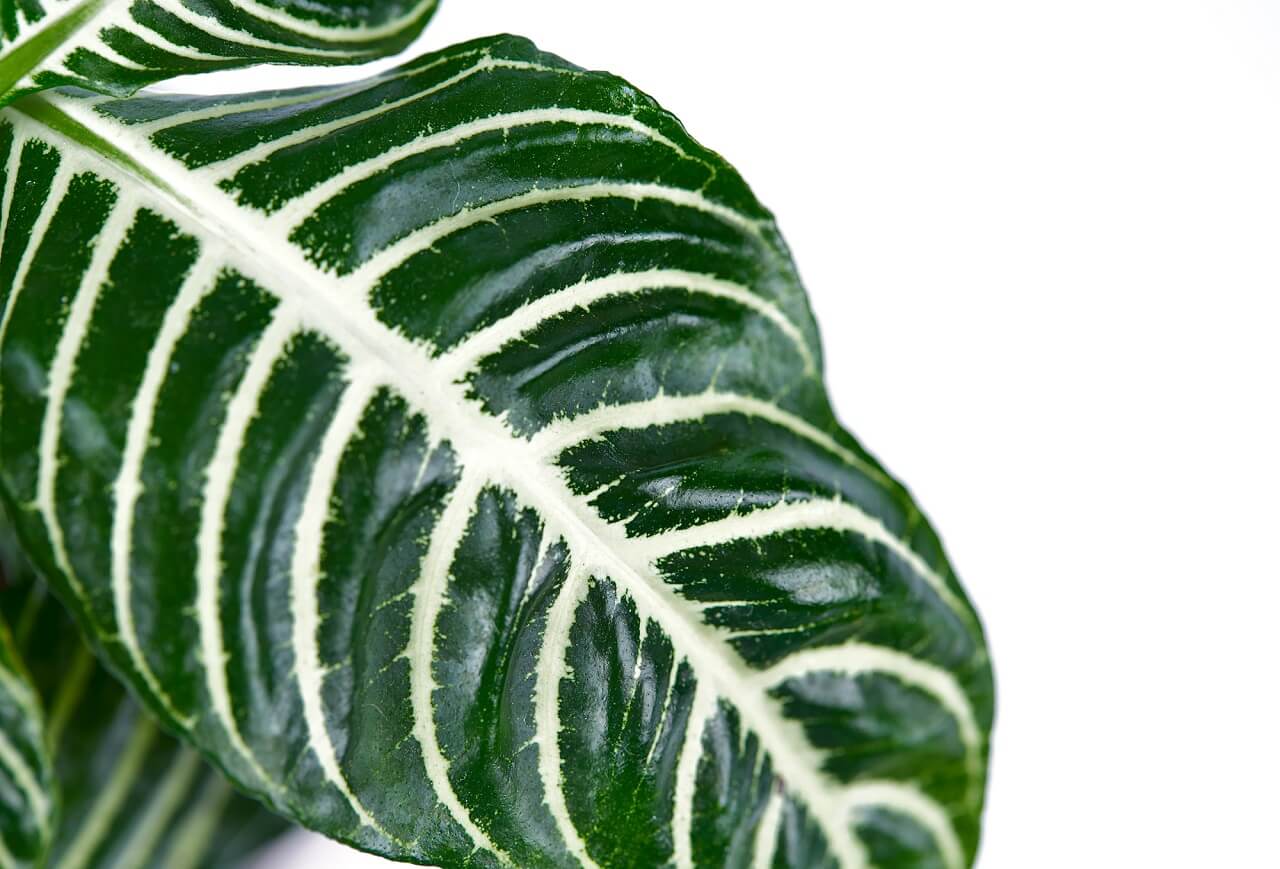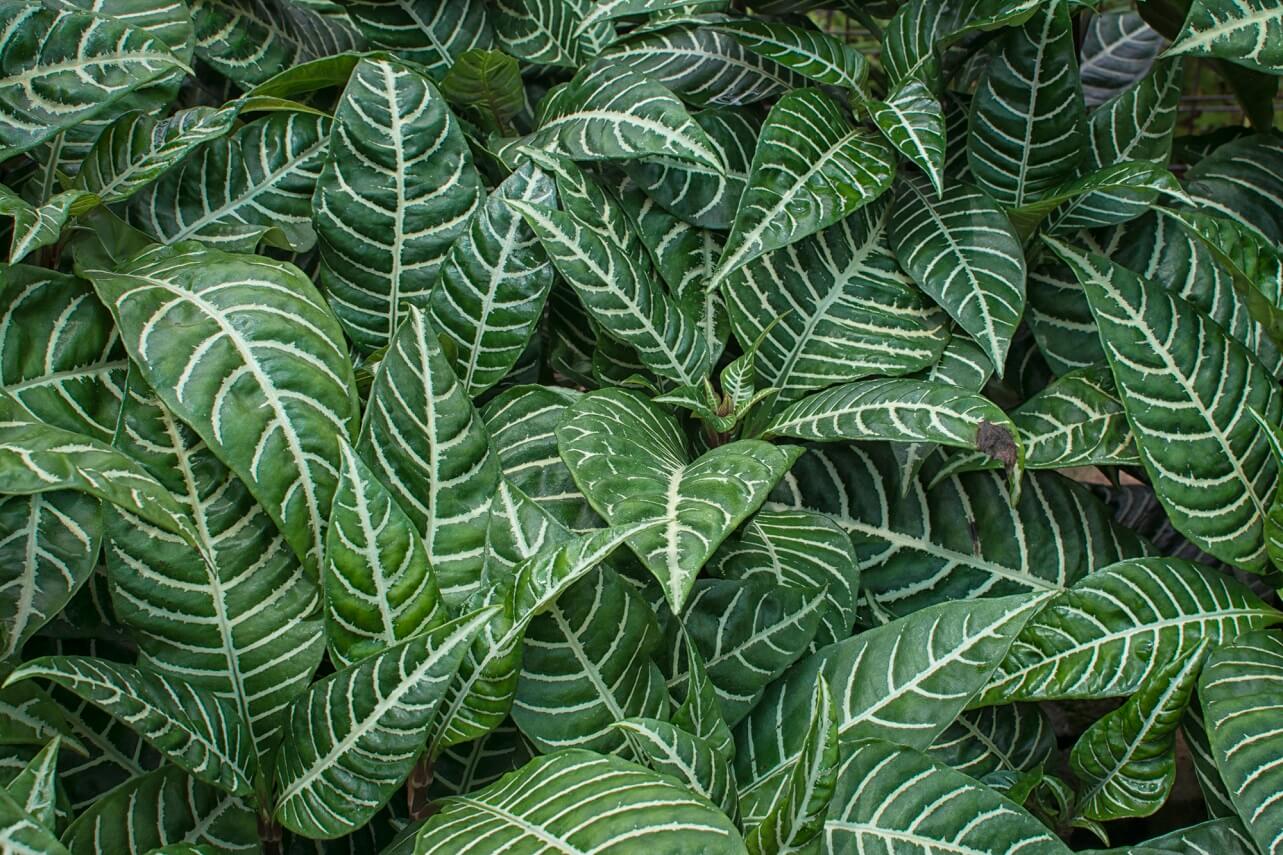Aphelandra squarrosa, or zebra plants, are fussy houseplants that let you know loud and clear when something is amiss. The problem is, it’s not always easy to figure out what they need, and the symptoms of different problems often overlap. So how to save a dying zebra plant?
In this article, we’ll go through common problems with unhappy zebra plants, diagnose the issue, and troubleshoot.
What You'll Learn Today
Why Is My Zebra Plant Turning Yellow?

When your zebra plant’s vibrant green and white leaves start to turn yellow, you know that something’s up. Here are some of the main reasons for yellow leaves.
The Problem: Overwatering
Many plant owners have been guilty of overwatering at one time or another. It seems counterintuitive to leave a plant alone for many days at a time without watering it, but often that’s exactly what they need.
When your zebra plant’s leaves are yellowing, check the soil. If it feels soggy or there’s standing water long after you water it, it needs to dry out.
If the stems are soft and mushy, that’s another telltale sign of overwatering. Overwatering that isn’t draining from the soil prevents the roots from getting the oxygen they need to absorb the water. This leads to root rot, which can be fatal.
The Fix
To save an overwatered zebra plant, take it out of the wet soil as soon as you notice the issue. Take a good look at the roots – are they all black and mushy? If they are, your plant may not make it.
If just a few roots look damaged or dead, you can try removing them and repotting the zebra plant in fresh soil. If your efforts were successful, you should see your plant start to perk up within 1-2 weeks.
The Problem: Underwatering
It should be a little easier to tell if your zebra plant is thirsty. If you stick your finger in the soil and it’s dry to the touch greater than 2 inches deep, it needs water ASAP.
Some other symptoms of underwatering include dry, crinkly leaves, brown tipped leaves, and wilting.
The Fix
If you think this is the case, water your plant deeply until water is freely draining out of the drainage hole. If this was the only issue, your zebra plant may perk up in a matter of hours.
Leaves that have turned yellow, however, will never be green again. You can remove any yellow, brown, or otherwise damaged leaves that you see anytime.
The Problem: Cold Drafts
Zebra plants are picky about temperature. In their native tropical rainforests of Central and South America, they flourish in warm, humid climates.
If your zebra plant is next to a drafty window where it’s exposed to temperatures below 65 degrees Fahrenheit on a regular basis, its leaves can yellow and fall off.
The Fix
Move the plant away from drafty windows or try to insulate the area better if possible. A space heater may do more harm than good since they tend to dry the air too much.
The Problem: Not Enough Light
One of the best indicators that your plant isn’t getting enough light is the location of the yellow leaves. If it’s mostly occurring in the lower leaves, or the areas with less light, you can assume that it needs more.
The Fix
If your zebra plant is not in bright, indirect light, and you don’t have anywhere else to put it, consider supplementing with a grow light. You can buy a fluorescent full-spectrum plant light, which comes in many styles and sizes.
Another simple option is to buy a full-spectrum light bulb that’s specifically designed for houseplants. You can use this in a mini desk lamp that’s adjustable so that you can position it directly over your plant.
What Causes Zebra Plant Leaves to Turn Brown at the Tips?

Much like yellowing leaves, brown tips on leaves are commonly caused by issues with watering. But sometimes, that’s only part of the picture. Here’s what might be happening with your zebra plant:
The Problem: Underwatering
As mentioned above, check how the soil feels to determine whether your zebra plant needs to be watered.
The Problem: Scorched leaves
Another big cause of brown leaves is excessive light. If your zebra plant is getting any direct sunlight, particularly strong afternoon sun, the tips of its leaves often get burnt and brown.
More symptoms of too much light include leaves that are dry, crinkly, and wilting.
The Fix
Zebra plants only tolerate a little bit of direct sunlight during fall and winter, when the sun isn’t so harsh. If you’re keeping your plant in a southern-facing window in spring and summer, move it a few feet away from the window.
You can also put up a sheer curtain between a sunny window and your plant. Zebra plants, like many other tropical houseplants, love filtered sunlight.
Be sure not to overcompensate by putting the plant in low light. Zebra plants need bright, indirect light for optimal growth.
The Problem: Pests
Zebra plants are not inherently prone to pests, but that doesn’t mean that insect infestation cannot occur. Houseplant pests often cause issues like brown spots on leaves, leaf dropping, wilting, and damaged roots.
The best way to tell if a houseplant has pests is to do a thorough inspection of the leaves and stem. If you find anything, you can usually take a picture and identify it using an app or Google search.
The Fix
The solution to your pest problem will depend on which kind of insect is bothering your zebra plant. But in general, you should start by rinsing off the leaves and using insecticidal soap to kill whatever is on the plant.
If you can still see bugs on the plant, use a cotton swab dipped in rubbing alcohol to remove them.
To prevent insects in the future, make sure you’re following all of the preferred growing conditions for your zebra plant. Always use fresh (never reused) soil and clean pots when planting or repotting.
When you first purchase a zebra plant (or any other houseplant), isolate it for a couple of weeks to ensure that no signs of pests crop up before you expose it to your other plants.
The Problem: Lack of Humidity
Zebra plants need consistent high humidity to live happily in your home. They thrive best in humidity levels of at least 60%.
The Fix
The easiest and most effective way to boost humidity is to place a humidifier a few feet away from your zebra plant. Other options include setting it on a pebble tray and grouping it with other humidity-loving houseplants.
Why Is My Zebra Plant Losing Leaves?
It’s common for zebra plants to start angrily dropping leaves when they’re upset. This can happen for a multitude of reasons – many of which have been detailed above.
Here are some of the issues to check for when your zebra plant is losing its leaves:
- Underwatering
- Overwatering
- Cold drafts
- Too Much Fertilizer
- Lack of Humidity
- Too Much Light
For a great example of how to diagnose a sick zebra plant based on its appearance, watch this YouTube video:
Diagnosing an unhappy zebra plant can be a tedious, frustrating process. If only plants could talk to us and tell us what’s bothering them!
No matter how desperate the situation seems with your plant, however, make sure you give it time to recover in between each attempted solution. Zebra plants don’t like their conditions to be changed constantly, and too much love can be deadly for them.
I’ve seen insects on my Zebra Plant. Can I use a pesticide on it?
You can, but you shouldn’t necessarily use chemicals on indoor plants – these can be damaging to your living space! If your Zebra Plant has unwanted guests, try a few natural solutions first. Identify the pest, then use nematodes (natural predators) to control the problem. Neem oil is also a great, natural insect repellent.